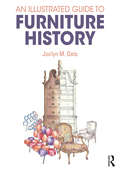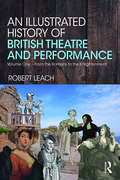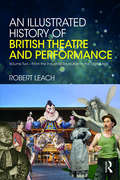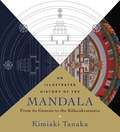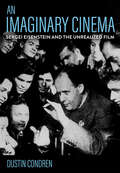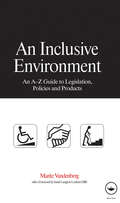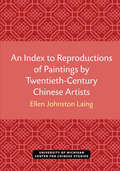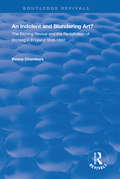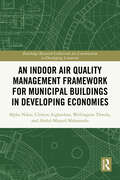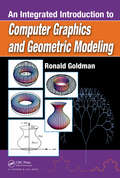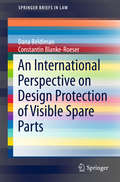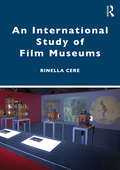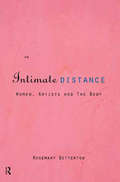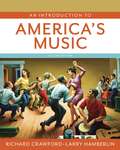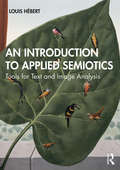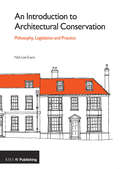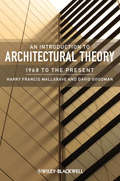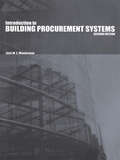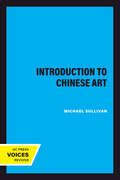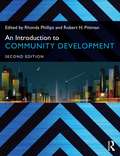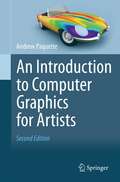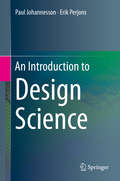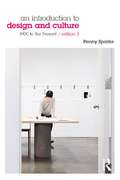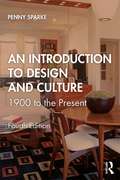- Table View
- List View
An Illustrated Guide to Furniture History
by Joclyn M. OatsAn Illustrated Guide to Furniture History provides upper-level students and instructors with an alternative visual analytical approach to learning about furniture history from Antiquity to Postmodernism. Following an immersive teaching model, it presents a Nine-Step Methodology to help students strengthen their visual literacy and quickly acquire subject area knowledge. Moving chronologically through key periods in furniture history and interior design, such as the Renaissance, the Arts and Crafts Movement, and Modernism, it traverses Europe to America to present a comprehensive foundational guide to the history of furniture design. Part I addresses furniture within the context of the built environment, with chapters exploring the historical perspective, construction principles, and the categorization of furniture. In Part II, the author visually depicts the structural organization of the methodological process, a three-category framework: History, Aesthetics, and Visual Notes. The chapters in this part prepare the reader for the visual analysis that will occur in the final section of the book. The book is lavishly illustrated in full color with over 300 images to reinforce visual learning and notation. A must-have reference and study guide for students in industrial and product design, interior design, and architecture.
An Illustrated History of British Theatre and Performance: Volume One - From the Romans to the Enlightenment
by Robert LeachAn Illustrated History of British Theatre and Performance chronicles the history and development of theatre from the Roman era to the present day. As the most public of arts, theatre constantly interacts with changing social, political and intellectual movements and ideas, and Robert Leach’s masterful work restores to the foreground of this evolution the contributions of women, gay people and ethnic minorities, as well as the theatres of the English regions, and of Wales and Scotland. Highly illustrated chapters trace the development of theatre through major plays from each period; evaluations of playwrights; contemporary dramatic theory; acting and acting companies; dance and music; the theatre buildings themselves; and the audience, while also highlighting enduring features of British theatre, from comic gags to the use of props. This first volume spans from the earliest forms of performance to the popular theatres of high society and the Enlightenment, tracing a movement from the outdoor and fringe to the heart of the social world. The Illustrated History acts as an accessible, flexible basis for students of the theatre, and for pure fans of British theatre history there could be no better starting point.
An Illustrated History of British Theatre and Performance: Volume Two - From the Industrial Revolution to the Digital Age
by Robert LeachAn Illustrated History of British Theatre and Performance chronicles the history and development of theatre from the Roman era to the present day. As the most public of arts, theatre constantly interacted with changing social, political and intellectual movements and ideas, and Robert Leach’s masterful work restores to the foreground of this evolution the contributions of women, gay people and ethnic minorities, as well as the theatres of the English regions, and of Wales and Scotland. Highly illustrated chapters trace the development of theatre through major plays from each period; evaluations of playwrights; contemporary dramatic theory; acting and acting companies; dance and music; the theatre buildings themselves; and the audience, while also highlighting enduring features of British theatre, from comic gags to the use of props. Continuing on from the Enlightenment, Volume Two of An Illustrated History of British Theatre and Performance leads its readers from the drama and performances of the Industrial Revolution to the latest digital theatre. Moving from Punch and Judy, castle spectres and penny showmen to Modernism and Postdramatic Theatre, Leach’s second volume triumphantly completes a collated account of all the British Theatre History knowledge anyone could ever need.
An Illustrated History of the Mandala: From Its Genesis to the Kalacakratantra
by Kimiaki TanakaEveryone’s heard of mandalas; now we have a uniquely rich history and explanation of their history and meaning.This book is a history of the genesis and development of the mandala from the fifth and sixth centuries, when the mandala first appeared in India, to the eleventh century, when the Kalacakratantra appeared just before the disappearance of Buddhism in India. The 600 years of Indian esoteric Buddhism that concluded the 1,700-year history of Indian Buddhism could be said to have been the history of the development of the mandala. (The Kalacakratantra integrated earlier mandala theories into a single system and established a monumental system unprecedented in the history of esoteric Buddhism. It was thus the culmination of the development of Indian Buddhism over a period of 1,700 years.) The analysis is at the micro level and includes numerous illustrations and charts. Particular attention is paid to proper names, mudras, and mantras that have been overlooked by scholars in philosophy and doctrine, and the author tackles issues that cannot be explained solely from a historical viewpoint, such as geometric patterns, the arrangement of deities, the colors, and their meaning in Buddhist doctrine.
An Illustrated Journey: Inspiration From the Private Art Journals of Traveling Artists, Illustrators and Designers
by Danny GregoryTravel + Sketching = InspirationWhen we travel, we don't want to follow the same itinerary as everyone who's come before us. We want to feel like explorers, adventurers in undiscovered territory. And that's exactly what sketching can bring to the travel experience.An Illustrated Journey captures the world through the eyes of 40 talented artists, illustrators and designers. You'll experience the wonder of seeing familiar sights through a fresh lens but, more important, you'll be inspired to set pen to paper and capture your own vistas.The really wonderful thing about a sketchbook is that it can be totally private. You don't have to have an ounce of talent to enjoy learning how to really see what's in front of you. But lucky for us, the sketchbooks captured here are lovely, creative, intimate windows into each artist's mind.So, whether you're just returning to the art of drawing, abandoned by most of us after childhood, or you're looking for inspiration to take your illustration work in a new direction, An Illustrated Journey will take you on a wonderful trip of the imagination. All you need to pack are a pencil and a piece of paper.
An Imaginary Cinema: Sergei Eisenstein and the Unrealized Film
by Dustin CondrenAn Imaginary Cinema is the first systematic study of Sergei Eisenstein's unrealized films as well as a deeply informed historical and theoretical inquiry into the role and meaning of the unmade in his oeuvre. Eisenstein directed some of the twentieth century's most important films, from the early classic of montage, Battleship Potemkin, to his late masterpiece, Ivan the Terrible. Alongside these, however, the Soviet filmmaker also toiled over a compelling array of unrealized projects, from ideas that never grew beyond complex, passionate notebook scrawls and sketches to productions that were mounted and shot to some degree of completion without ever being finished. Working from the archival remnants of several of the director's most fascinating unrealized projects—from his bold vision to film Marx's Das Kapital to his time in Hollywood struggling to adapt Dreiser's An American Tragedy—Dustin Condren's book reveals new aspects of Eisenstein's genius, showing the filmmaker in a constant state of process, open to working toward impossible and sometimes utopian ends, and committed to the pursuit of creative and theoretical discovery. Condren's analysis of these unrealized projects in An Imaginary Cinema reveals Eisenstein at crucial moments of his personal and artistic biography, and it also tells the wider story of a canonical artist negotiating the political labyrinths of Stalinist Russia, the economic pitfalls of Hollywood, and the technological shifts of early cinema.
An Inclusive Environment
by Maritz VandenbergPeople can be excluded from freedom and the good things in life by age, disability, poverty, unfair discrimination, crime or the fear of crime, and arrogant and unresponsive governments. This practical reference deals with all of these factors, and shows the links between them. In addition to several hundred shorter notes it includes over a thousand major entries, each of which comprises: a summary of relevant facts, incisive commentary to help readers cut through the fog of jargon and propaganda that confuses many of these issues and websites where the latest information may be found. It concludes with a detailed bibliography of around 500 useful references. The work will be found useful by professionals and managers in all walks of life; by central and local government officials and representatives, and by students in the social sciences. It devotes particular attention to the all-important Disability Discrimination Act, and numerous detailed entries, accompanied in many cases by elegant diagrams, suggest to architects and other designers, facilities managers, and personnel managers how the requirements of the Act may be met.
An Index to Reproductions of Paintings by Twentieth-Century Chinese Artists (Michigan Monographs In Chinese Studies #76)
by Ellen Johnston LaingIn the second half of the twentieth century, studies in Chinese painting history have been greatly aided by several major lists of Chinese artists and their works. Published between 1956 and 1980, these lists were limited to Imperial China. The current index covers the period from 1912 to around 1980. It includes the names of approximately 3,500 traditional-style artists along with lists of their works, reproduced in some 264 monographs, books, journals, and catalogs published from the 1920s to around 1980. With a few exceptions, artists working after 1949 outside continental China are excluded. Revised Edition, 1998; first published by the Asian Studies Program, University of Oregon, 1984.
An Indolent and Blundering Art?: The Etching Revival and the Redefinition of Etching in England (Routledge Revivals)
by Emma ChambersFirst published in 1999, Chambers explores English etching changed that radically during the nineteenth century. This book looks into the freedom and directness of the etching process became a key plank in a sustained attempt to raise the status of etching in Britain spearheaded by artists such as Francis Seymour Haden and James McNeill Whistler and members of the Etching Club. An Indolent and Blundering Art? Opens with a description of the use of language and art criticism to redefine etching
An Indoor Air Quality Management Framework for Municipal Buildings in Developing Economies (Routledge Research Collections for Construction in Developing Countries)
by Clinton Ohis Aigbavboa Wellington Didibhuku Thwala Abdul-Majeed Mahamadu Mpho NdouThis book delves into the pivotal issue of Indoor Air Quality (IAQ) management in municipal buildings within developing economies, addressing a pressing need in today’s digital age, where individuals spend over 70% of their time indoors. With a strong focus on enhancing environmental quality, this book presents theoretical frameworks and practical recommendations designed explicitly for stakeholders in the higher education sector, encompassing both public and private institutions.As institutions strive to improve their learning environments, this book aligns with global Sustainable Development Goals (SDGs), highlighting the vital connection between effective IAQ management and the health and well-being of the institutional community, including students and staff members. It provides a comprehensive framework that advocates for improved IAQ management and emphasises the importance of quality education and lifelong learning.Furthermore, this book serves as a valuable resource for green building regulatory bodies, ensuring adherence to best practices in IAQ management within municipal buildings. By providing actionable strategies grounded on recent literature, the book is an essential guide for researchers and policymakers seeking to navigate the theoretical and empirical dimensions of IAQ management. Moreover, this book asserts that enhancing IAQ is necessary not only for regulatory compliance and community well-being but also as a vital investment in the academic and operational success of municipal buildings in developing economies.
An Integrated Introduction to Computer Graphics and Geometric Modeling (Chapman & Hall/CRC Computer Graphics, Geometric Modeling, and Animation Series)
by Ronald GoldmanTaking a novel, more appealing approach than current texts, An Integrated Introduction to Computer Graphics and Geometric Modeling focuses on graphics, modeling, and mathematical methods, including ray tracing, polygon shading, radiosity, fractals, freeform curves and surfaces, vector methods, and transformation techniques. The author begins with f
An International Perspective on Design Protection of Visible Spare Parts
by Dana Beldiman Constantin Blanke-RoeserThis publication examines the legal aspects of the spare parts market from an IP perspective: specifically whether design protection for spare parts of a complex product extends to the spare part aftermarket, or whether that market should remain open to competition. The stakeholders’ equally weighty arguments that must be balanced against are, on the one hand, the property interest in an earned IP right in the design of the part; and on the other, enhanced competition, likely reflected in lower prices. The mounting tension between these two positions is manifest an increased number of lawsuits in both the US and the EU.This book provides a discussion of the legal issues involved in this debate from a global perspective, with special focus on the EU and the US. Part I contextualizes the legal debate by discussing the historical background, the competitive situation and the respective stakeholder positions. Part II examines the relevant legal questions on a comparative basis, evaluating the likelihood of its adoption in the jurisdictions examined. Concluding that adoption is unlikely, Part III proposes a number of possible considerations meant to further compromise. Part IV concludes with a future outlook, specifically in light of the impact of technological development on this market.
An International Study of Film Museums
by Rinella CereAn International Study of Film Museums examines how cinema has been transformed and strengthened through museological and archival activities since its origins and asks what paradoxes may be involved, if any, in putting cinema into a museum. Cere explores the ideas that were first proposed during the first half of the twentieth century around the need to establish national museums of cinema and how these have been adapted in the subsequent development of the five case studies presented here: four in Europe and one in the USA. The book traces the history of the five museums' foundation, exhibitions, collections, and festivals organised under their aegis and it asks how they resolve the tensions between cinema as an aesthetic artefact – now officially recognised as part of humanity's cultural heritage – and cinema as an entertainment and leisure activity. It also gives an account of recent developments around unifying collections, exhibition activities and archives in one national film centre that offers the general public a space totally devoted to film and cinematographic culture. An International Study of Film Museums provides a unique comparative study of museums of cinema in varying national contexts. The book will be of interest to academics and students around the world who are engaged in the study of museums, archives, heritage, film, history and visual culture.
An Intimate Distance: Women, Artists and the Body
by Rosemary BettertonAn Intimate Distance considers a wide range of visual images of women in the context of current debates which centre around the body, including reproductive science, questions of ageing and death and the concept of 'body horror' in relation to food, consumption and sex. A feminist reclamation of these images suggests how the permeable boundaries between the female body and technology, nature and culture are being crossed in the work of women artists.
An Introduction to America's Music
by Richard Crawford Larry HamberlinRichard Crawford and Larry Hamberlin show how the lively interactions between the folk, popular, and classical spheres have made American music resonate with audiences around the world. Students will learn how to listen critically to eighty-eight pieces in all the major styles and genres, while gaining a clearer understanding of music's role in the history of American society, business, and technology.
An Introduction to Applied Semiotics: Tools for Text and Image Analysis
by Louis HébertAn Introduction to Applied Semiotics presents nineteen semiotics tools for text and image analysis. Covering a variety of different schools and approaches, together with the author’s own original approach, this is a full and synthetic introduction to semiotics. This book presents general tools that can be used with any semiotic product. Drawing on the work of Fontanille, Genette, Greimas, Hébert, Jakobson, Peirce, Rastier and Zilberberg, the tools deal with the analysis of themes and action, true and false, positive and negative, rhythm narration and other elements. The application of each tool is illustrated with analyses of a wide range of texts and images, from well-known or distinctive literary texts, philosophical or religious texts or images, paintings, advertising and everyday signs and symbols. Each chapter has the same structure – summary, theory and application – and includes exercises and discussion questions, making it ideal for course use. Covering both visual and textual objects, this is a key text for all courses in semiotics and textual analysis within linguistics, communication studies, literary theory, design, marketing and related areas.
An Introduction to Architectural Conservation: Philosophy, Legislation and Practice
by Nick Lee EvansThere are over half a million listed buildings in Britain, conservation areas can be found in every borough, and a large proportion of our housing stock pre-dates 1914. So, whether in extending a listed house, reordering a local church, or converting an historic warehouse, most architects will work with historic buildings at some point in their career – even if they are not a specialist conservation architect.An Introduction to Architectural Conservation introduces non-specialist architects to the principles behind legislation concerning historic buildings. It will help them understand the practicalities of this legislation, the aims and objectives of Conservation Offices, Statutory Amenity Societies and other guardians of our heritage. With these skills, readers can advise clients more accurately, make successful listed building applications, and ensure their interventions are sensitive, appropriate and effective. An Introduction to Architectural Conservation is also a practical guide to good working practice: taking readers through the process of preparing a listed building application, preparing a suitable tender package and administering the contract..
An Introduction to Architectural Theory: 1968 to the Present
by David J. Goodman Harry Francis MallgraveA sharp and lively text that covers issues in depth but not to the point that they become inaccessible to beginning students, An Introduction to Architectural Theory is the first narrative history of this period, charting the veritable revolution in architectural thinking that has taken place, as well as the implications of this intellectual upheaval. The first comprehensive and critical history of architectural theory over the last fifty years surveys the intellectual history of architecture since 1968, including criticisms of high modernism, the rise of postmodern and poststructural theory, critical regionalism and tectonics Offers a comprehensive overview of the significant changes that architectural thinking has undergone in the past fifteen years Includes an analysis of where architecture stands and where it will likely move in the coming years
An Introduction to Building Procurement Systems
by J.W.E. Masterman Dr Jack Masterman Jack MastermanFirst Published in 2003. Routledge is an imprint of Taylor & Francis, an informa company.
An Introduction to Chinese Art
by Michael SullivanThis title is part of UC Press's Voices Revived program, which commemorates University of California Press’s mission to seek out and cultivate the brightest minds and give them voice, reach, and impact. Drawing on a backlist dating to 1893, Voices Revived makes high-quality, peer-reviewed scholarship accessible once again using print-on-demand technology. This title was originally published in 1960.This title is part of UC Press's Voices Revived program, which commemorates University of California Press’s mission to seek out and cultivate the brightest minds and give them voice, reach, and impact. Drawing on a backlist dating to 1893, Voices Revived</DIV
An Introduction to Community Development
by Rhonda Phillips Robert PittmanBeginning with the foundations of community development, An Introduction to Community Development offers a comprehensive and practical approach to planning for communities. Road-tested in the authors’ own teaching, and through the training they provide for practicing planners, it enables students to begin making connections between academic study and practical know-how from both private and public sector contexts. An Introduction to Community Development shows how planners can utilize local economic interests and integrate finance and marketing considerations into their strategy. Most importantly, the book is strongly focused on outcomes, encouraging students to ask: what is best practice when it comes to planning for communities, and how do we accurately measure the results of planning practice? This newly revised and updated edition includes: increased coverage of sustainability issues, discussion of localism and its relation to community development, quality of life, community well-being and public health considerations, and content on local food systems. Each chapter provides a range of reading materials for the student, supplemented with text boxes, a chapter outline, keywords, and reference lists, and new skills based exercises at the end of each chapter to help students turn their learning into action, making this the most user-friendly text for community development now available.
An Introduction to Computer Graphics for Artists
by Andrew PaquetteAn Introduction to Computer Graphics for Artists is an application-independent, reader-friendly primer for anyone with a serious desire to understand 3D Computer Graphics. Written by a veteran of the computer graphics industry whose previous career included film animation and various spells as Art Director for video games, Andrew Paquette draws on his experiences both as an artist and a manager. Far too often artists, even professionals, lack a basic understanding of the principles of computer graphics. The result is inefficiency and lower quality of work. This book addresses these issues by providing fundamental information in a university course format, with theoretical material, detailed illustrations, and projects to test the reader's understanding of the concepts covered. Opening with the first and most basic elements of computer graphics, the book rapidly advances into progressively more complex concepts. Each of the elements, however simple, are important to understand because each is an essential link in a chain that allows an artist to master any computer graphics application. With this accomplished, the artist can use technology to satisfy his goals, instead of the technology being master of the artist. All students wanting to learn more about computer graphics from an artistic viewpoint, particularly those intending to pursue a career in computer game design or film animation, will find this book invaluable.
An Introduction to Design Science
by Paul Johannesson Erik PerjonsThis book is an introductory text on design science, intended to support both graduate students and researchers in structuring, undertaking and presenting design science work. It builds on established design science methods as well as recent work on presenting design science studies and ethical principles for design science, and also offers novel instruments for visualizing the results, both in the form of process diagrams and through a canvas format. While the book does not presume any prior knowledge of design science, it provides readers with a thorough understanding of the subject and enables them to delve into much deeper detail, thanks to extensive sections on further reading. Design science in information systems and technology aims to create novel artifacts in the form of models, methods, and systems that support people in developing, using and maintaining IT solutions. This work focuses on design science as applied to information systems and technology, but it also includes examples from, and perspectives of, other fields of human practice. Chapter 1 provides an overview of design science and outlines its ties with empirical research. Chapter 2 discusses the various types and forms of knowledge that can be used and produced by design science research, while Chapter 3 presents a brief overview of common empirical research strategies and methods. Chapter 4 introduces a methodological framework for supporting researchers in doing design science research as well as in presenting their results. This framework includes five core activities, which are described in detail in Chapters 5 to 9. Chapter 10 discusses how to communicate design science results, while Chapter 11 compares the proposed methodological framework with methods for systems development and shows how they can be combined. Chapter 12 discusses how design science relates to research paradigms, in particular to positivism and interpretivism. Lastly, Chapter 13 discusses ethical issues and principles for design science research.
An Introduction to Design and Culture: 1900 to the Present
by Penny SparkeThis third edition of An Introduction to Design and Culture has been revised and updated throughout to include issues of globalization, sustainability and digital/interactive design. New for this edition is a chapter which covers key changes in design culture. Design culture has changed dramatically in the 21st century, the designer-hero is now much less in evidence and design has become much more interdisciplinary. Drawing on a wealth of mass-produced artefacts, images and environments including sewing machines, cars, televisions, clothes, electronic and branded goods and exhibitions, author Penny Sparke shows how design has helped to shape and reflect our social and cultural development. This introduction to the development of modern (and postmodern) design is ideal for undergraduate students.
An Introduction to Design and Culture: 1900 to the Present
by Penny SparkeAn Introduction to Design and Culture provides a comprehensive guide to the changing relationships between design and culture from 1900 to the present day with an emphasis on five main themes: Design and consumption Design and technology The design profession Design theory Design and identities This fourth edition extends the traditional definition of design as covering product design, furniture design, interior design, fashion design and graphic design to embrace its more recent manifestations, which include service design, user-interface design, co-design, and sustainable design, among others. It also discusses the relationship between design and the new media and the effect of globalisation on design. Taking a broadly chronological approach, Professor Sparke employs historical methods to show how these themes developed through the twentieth century and into the twenty-first century and played a role within modernism, postmodernism and beyond. Over a hundred illustrations are used throughout to demonstrate the breadth of design and examples – among them design in Modern China, the work of Apple Computers Ltd., and design thinking – are used to elaborate key ideas. The new edition remains essential reading for undergraduate and postgraduate students of design studies, cultural studies and visual arts.
